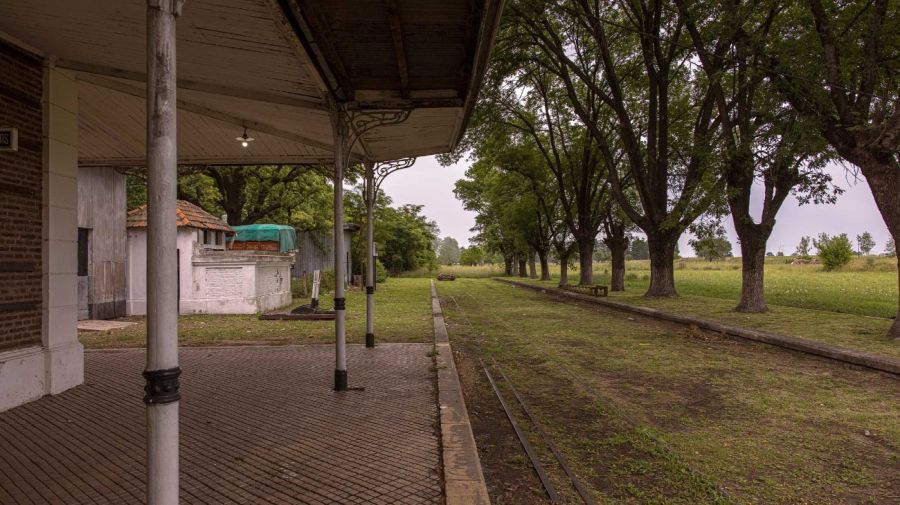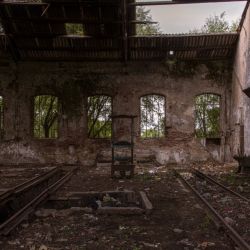Patricios, Argentina, looks like a railroad version of the Titanic. Rotting rail ties and shattered glass litter the gutted train warehouse. The town’s economic engine is long abandoned except for the manager’s former office, now a makeshift home for a family of 11. The community doesn’t have a single employer and there’s no sewer, natural gas or paved roads.
Deep in Buenos Aires Province, the forgotten town off a muddy road lays bare the root problem facing Javier Milei as he begins his Presidency in Argentina vowing to end decades of overspending.
Home to 5,000 residents a few generations back, Patricios cast fewer than 600 votes in the November election. Its decline mirrors that of Argentina itself.
Once Latin America’s best, the nation’s rail system crumbled with its economy over the decades, leaving in its wake hundreds of ghost towns like Patricios. But even though Argentina’s passenger network has shrunk to a little more than 5,000 kilometres (3,105 miles) today from 46,000 kilometres in 1945, state-run Trenes Argentinos employs more people than Amtrak in the United States or Spain’s high-speed rail network, Renfe.
Towns like Patricios, where the majority depends on social security or welfare cheques, illustrate Milei’s greatest challenge: managing a cratering economy that’s trying to prop up a bloated state. As the president himself warns, taming runaway spending will be painful, so town residents are bracing for the worst.
Argentina “is a train on an open track and there’s no station,” says Carlos Tomas Guiotto, the municipal representative, who calls Patricios a barometer for national trends. “We’ll either find the station or we’ll head out into the fields, fall into a ditch and end in disaster.”
Since 1950, Argentina has spent more time in recession than any other nation except the Democratic Republic of Congo. This year is no different, with the economy lurching into its sixth downturn in a decade.
The country’s US$43-billion deal with the International Monetary Fund, its only remaining lifeline, is fraying because the previous government missed deficit targets, spending big before losing the election by a landslide. Trenes Argentinos is a microcosm of the bigger fiscal picture: The state set aside 338 billion pesos in aid for its railway services in this year’s budget, worth US$2.2 billion at the time it was approved by Congress.
Part of Milei’s chainsaw remedy is to privatise the train service, the biggest public employer, among an alphabet soup of other state-run enterprises. “The only possible solution is austerity — orderly austerity that falls with all its force on the state and not the private sector,” he said after his inauguration. “It's not going to be easy.”
But Argentina’s last attempt at railway privatisation failed in the early 1990s as companies abandoned unprofitable lines constructed in the nation’s boom days a century ago. More stations shuttered, and service has improved only glacially in recent years.
The first batch of shock-therapy measures aim to reduce state spending by nearly three percent of gross domestic product. While Wall Street investors are cheering the cuts as long-overdue economic medicine — even if it means higher inflation initially as subsidies, government jobs and welfare are eliminated — those on the ground are increasingly anxious.

María Gastaminza breaks down as she describes her fears about Milei, partly fanned by the former government’s misinformation campaign. She’s endured a life of hardship, giving birth at 14 and single parenting most of the years since then. Now 42, Gastaminza inhabits the abandoned railway warehouse in Patricios, converting the old manager’s office and one bathroom into a home for nine of her 10 kids and her current partner, Carlos Rodríguez.
Several of her children receive a state subsidy to cover prescription medicine for celiac disease, thyroid problems and childhood arthritis. And her 12-year-old fears she won’t be able to go to school if Milei privatises Argentina’s education system — a rumour spread by his opponents, which he denies.
“To be honest, I cried on election day when he won. I was hurting for my kids,” Gastaminza says. “Six of us take daily medications that costs 10,000 pesos for each one, and if I have to pay for everyone’s medication, we can’t keep taking it.”
Milei's spending cuts are coming at a particularly bad time for her town. After years of waiting for a gas pipeline to heat homes and service kitchens, the provincial government put up a billboard announcing it would be installed in a year's time. But Milei’s administration is halting all public works projects that haven't already begun.
Gastaminza, who herself receives a stipend for mothers with several children, says she’s ready to work. But in Patricios “there’s no jobs for women,” so she and the oldest children earn extra income by feeding calves that they sell when they’re ready for grazing. If need be, she says she’s willing to join Rodríguez on farms laying fences for cattle, a low-pay job in which her 14- and 18-year-old sons are already working in the biggest nearby town.
Fiscal austerity, however, spelled doom for Argentine leaders before Milei.
Mauricio Macri opted for gradual cuts during his Presidency, which proved fatal for him in the 2019 election. And in 2022, President Alberto Fernández’s economy minister Martín Guzmán abruptly resigned less than a year after being blasted by Vice-President Cristina Fernández de Kirchner as too austere. To cover its deficits, the former government printed more than six trillion pesos, which resulted in annual inflation that’s galloped past 160 percent.
Even by Latin American standards, Argentina is an outlier. Public spending is equivalent to 38 percent of GDP, more than the 35 percent regional average and well above the 24 percent seen in the country between 1993 and 2005, according to IMF data. Government jobs like the ones at Argentina’s train service have been the main driver of overspending since the mid 2000s, according to an analysis by economist Milagros Gismondi.
“There isn’t a real consciousness that you have to lower spending in Argentina,” says Gismondi, who was chief-of-staff at the Economy Ministry in 2019. “It’s not normal to operate with more train employees than in the United States,” she adds, and unless Argentines understand that’s not sustainable “we’ll continue from one crisis to another.”
Argentina’s state spending spree goes far beyond its railways, though. Governments have added nearly a million jobs to the public payroll since 2012, three times the gains seen in the private sector, Labour Ministry data shows. Welfare has also ballooned. The number of social security recipients who haven’t contributed to the system spiked above five million in 2020 from just 172,000 in 2002, according to a report by Andrés Schipani at CIAS, a university think-tank.
Born out of excess more than a century ago, the train service was nationalised by Juan Domingo Perón in 1948. The founder of the namesake pro-labour movement that dominated Argentine politics for decades branded the move “economic independence.” But in reality the companies operating the oversized network with a billowing payroll were on the brink of collapse, according to Jorge Waddell, a train historian and author of several books.
Whether democracies or dictatorships, Argentine governments of all stripes have proposed measures that never resolved the train system’s woes. Instead, many overhauls exacerbated spending, crushed service and saw the railway wither from a gluttonous operation to a skeleton of its former self.
Now it’s Milei’s turn and he’ll have to battle the same powerful labour groups that hobbled some of his predecessors. “The unions bring on much more personnel than before — trains today that carry 300 passengers have a staff of 15 or 16 employees,” Waddell said in an interview, noting trains carrying a thousand passengers in the 1980s were staffed by 10 workers or less. “No business can withstand this.”

Unsustainable spending on transit, however, may have already hit a dead end. Milei’s government plans to scrap subsidies in the Buenos Aires Metropolitan area that left the cost of commuter train rides at about US$0.10 and subway fares at US$0.06.
Such artificially low prices sometimes provoke chaos. In November, Argentines camped out overnight, queuing for several blocks to buy the few tickets available from the capital to oceanside Mar Del Plata because service is so limited and fares start at less than US$3 for the six-hour journey.
Other decisions defy logic. The government restarted service this year between Buenos Aires and the country’s wine capital, Mendoza, after a three-decade hiatus. A train fit for 400 passengers only had 60 people sign up for the gruelling 29-hour journey.
In the town of Mechita, Argentina’s government was set to pay US$864 million to Russia’s TMH International to build electric trains on a railway that wasn’t electrified. TMH sold its business this year, after global financial sanctions imposed on Russia for its invasion of Ukraine doomed the transaction.
Back in Patricios, Osvaldo Curti is the town’s only remaining railway mechanic. Long retired and widowed, he proudly flaunts the trade certification that led him to work on once-bustling railroads across the country, including the iconic “Train to Heaven” that snakes through the Andes.
The 88-year-old, who lives on his pension and late wife’s social security, worries Argentina is losing something much harder to fix than a budget deficit: a strong work ethic. He sees youth in Patricios opting for welfare cheques because they can cobble together other handouts that are either equal to or worth more than the minimum US$146 monthly wage.
“You’re better off snoozing belly up,” Curti complains.
He also sees society fraying at his doorstep. Nature is reclaiming the deserted home across from his, and one Saturday in November a drunk refusing to return to a geriatric facility stooped there for hours. Curti called the municipal rep, Guiotto, who couldn’t offer any help beyond talking to the man’s family, who wouldn’t take him back.
“There’s so much abandonment,” Curti says, peering from his front yard. “There’s no future.”
related news
by Patrick Gillespie, Bloomberg



























Comments